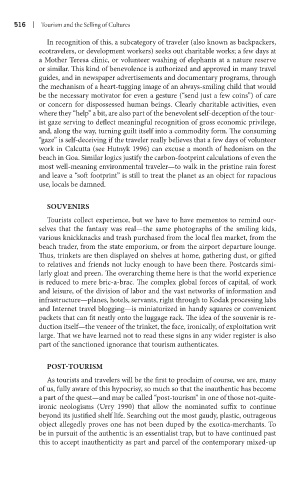Page 537 - Battleground The Media Volume 1 and 2
P. 537
1 | Tour sm and the Sell ng of Cultures
In recognition of this, a subcategory of traveler (also known as backpackers,
ecotravelers, or development workers) seeks out charitable works; a few days at
a Mother Teresa clinic, or volunteer washing of elephants at a nature reserve
or similar. This kind of benevolence is authorized and approved in many travel
guides, and in newspaper advertisements and documentary programs, through
the mechanism of a heart-tugging image of an always-smiling child that would
be the necessary motivator for even a gesture (“send just a few coins”) of care
or concern for dispossessed human beings. Clearly charitable activities, even
where they “help” a bit, are also part of the benevolent self-deception of the tour-
ist gaze serving to deflect meaningful recognition of gross economic privilege,
and, along the way, turning guilt itself into a commodity form. The consuming
“gaze” is self-deceiving if the traveler really believes that a few days of volunteer
work in Calcutta (see Hutnyk 1996) can excuse a month of hedonism on the
beach in Goa. Similar logics justify the carbon-footprint calculations of even the
most well-meaning environmental traveler—to walk in the pristine rain forest
and leave a “soft footprint” is still to treat the planet as an object for rapacious
use, locals be damned.
souvEnirs
Tourists collect experience, but we have to have mementos to remind our-
selves that the fantasy was real—the same photographs of the smiling kids,
various knickknacks and trash purchased from the local flea market, from the
beach trader, from the state emporium, or from the airport departure lounge.
Thus, trinkets are then displayed on shelves at home, gathering dust, or gifted
to relatives and friends not lucky enough to have been there. Postcards simi-
larly gloat and preen. The overarching theme here is that the world experience
is reduced to mere bric-a-brac. The complex global forces of capital, of work
and leisure, of the division of labor and the vast networks of information and
infrastructure—planes, hotels, servants, right through to Kodak processing labs
and Internet travel blogging—is miniaturized in handy squares or convenient
packets that can fit neatly onto the luggage rack. The idea of the souvenir is re-
duction itself—the veneer of the trinket, the face, ironically, of exploitation writ
large. That we have learned not to read these signs in any wider register is also
part of the sanctioned ignorance that tourism authenticates.
PosT-Tourism
As tourists and travelers will be the first to proclaim of course, we are, many
of us, fully aware of this hypocrisy, so much so that the inauthentic has become
a part of the quest—and may be called “post-tourism” in one of those not-quite-
ironic neologisms (Urry 1990) that allow the nominated suffix to continue
beyond its justified shelf life. Searching out the most gaudy, plastic, outrageous
object allegedly proves one has not been duped by the exotica-merchants. To
be in pursuit of the authentic is an essentialist trap, but to have continued past
this to accept inauthenticity as part and parcel of the contemporary mixed-up

